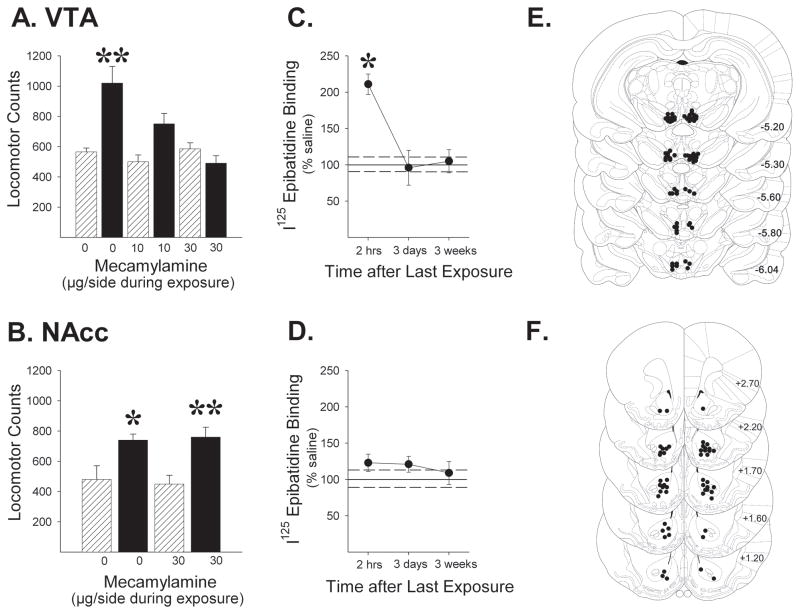Figure 1.
Blockade of nAChRs in the VTA (A), but not the NAcc (B), prevents locomotor sensitization by nicotine. Rats were exposed to 4 injections of nicotine (0.4mg/kg over 7 days, i.p.; ▬) or saline (
 ), with or without an i.c. injection of the nAChR antagonist mecamylamine and tested 3 weeks later for their locomotor response to nicotine (0.4 mg/kg). Mecamylamine was not injected on this test. n/group=6–7. Data are shown as group mean (+SEM) 2-hr session total locomotor counts obtained after the challenge injection. Line drawings (Paxinos & Watson, 1997; numbers indicate mm from bregma) indicating location of injection cannula tips in the VTA (E) and NAcc (F) are shown for rats included in the data analyses. C. Exposure to the same regimen increased 125I-epibatidine binding in the VTA observed at 2-hrs but not 3 days or 3 weeks following exposure. D. Significant nAChR upregulation was not observed in the NAcc at any time tested. n/group=7–10. Data (mean±SEMs) are expressed as % of saline controls (solid and dashed lines). Values for the saline control groups ranged from 90.0±15.81–130.09±10.22 fmol/mg protein in VTA and 55.68±6.96–64.62±8.91 fmol/mg protein in NAcc. No significant differences between control groups were observed in either the VTA (F(2,24)=2.07, NS) or the NAcc (F(2,32)=0.40, NS). *, p<0.05, **, p<0.01, compared to respective saline exposure controls.
), with or without an i.c. injection of the nAChR antagonist mecamylamine and tested 3 weeks later for their locomotor response to nicotine (0.4 mg/kg). Mecamylamine was not injected on this test. n/group=6–7. Data are shown as group mean (+SEM) 2-hr session total locomotor counts obtained after the challenge injection. Line drawings (Paxinos & Watson, 1997; numbers indicate mm from bregma) indicating location of injection cannula tips in the VTA (E) and NAcc (F) are shown for rats included in the data analyses. C. Exposure to the same regimen increased 125I-epibatidine binding in the VTA observed at 2-hrs but not 3 days or 3 weeks following exposure. D. Significant nAChR upregulation was not observed in the NAcc at any time tested. n/group=7–10. Data (mean±SEMs) are expressed as % of saline controls (solid and dashed lines). Values for the saline control groups ranged from 90.0±15.81–130.09±10.22 fmol/mg protein in VTA and 55.68±6.96–64.62±8.91 fmol/mg protein in NAcc. No significant differences between control groups were observed in either the VTA (F(2,24)=2.07, NS) or the NAcc (F(2,32)=0.40, NS). *, p<0.05, **, p<0.01, compared to respective saline exposure controls.

